Click on images to enlarge
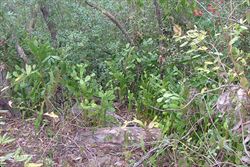
infestation (Photo: Sheldon Navie)
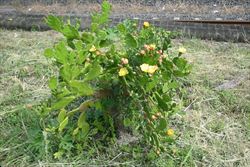
habit (Photo: Sheldon Navie)
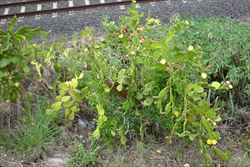
habit (Photo: Sheldon Navie)
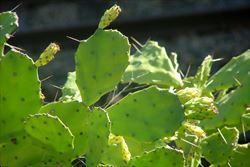
stem segments (Photo: Sheldon Navie)
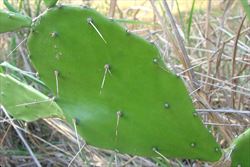
stem segment with spines (Photo: Sheldon Navie)
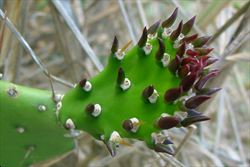
a young stem segment with tiny leaves (Photo: Sheldon Navie)
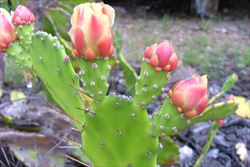
flower buds and young flowers (Photo: Sheldon Navie)
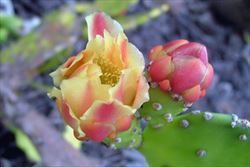
close-up of young flower (Photo: Sheldon Navie)
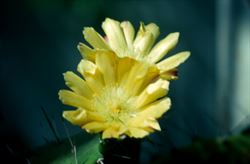
open flowers (Photo: Steve Adkins)

immature fruit (Photo: Sheldon Navie)
Scientific Name
Opuntia monacantha (Willd.) Haw.
Synonyms
Cactus monacanthus Willd.Platyopuntia brunneogemmia RitterPlatyopuntia vulgaris (Mill.) RitterOpuntia vulgaris Mill. (misapplied)
Family
Cactaceae
Common Names
Barbary fig, cochineal prickly pear, common prickly pear, drooping pear, drooping prickly pear, drooping tree pear, smooth tree pear, smooth-leaf tree pear, spiny prickly pear, spreading prickly pear, tuna
Origin
Native to South America (i.e. Argentina, Brazil, Paraguay and Uruguay).
Naturalised Distribution
This species has a very widespread distribution in Australia, however it is not particularly common. It is scattered in northern and south-eastern Queensland, eastern New South Wales, south-eastern South Australia, south-western Western Australia and Victoria. Also present in other parts of Queensland and New South Wales.
Also naturalised in other parts of the world, including Oceania (i.e. Fiji, Western Samoa, New Caledonia and Hawaii), South Africa and south-eastern USA.
Habitat
This species is mostly found in sub-tropical, semi-arid and warmer temperate environments. It is a weed of pastures, open woodlands, grasslands, roadsides, railways, creekbanks, disturbed sites, waste areas and sometimes also coastal environs.
Habit
An upright (i.e. erect), fleshy (i.e. succulent), tree-like plant usually growing 2-3 m tall, but occasionally reaching up to 6 m in height.
Distinguishing Features
- an upright, fleshy, tree-like plant usually growing 2-3 m tall.
- its stems consist of a series of very flattened fleshy segments.
- these spiny stem segments are hairless and some of them usually droop towards the ground.
- its showy flowers (3-6 cm across) are yellow with reddish-coloured markings on their outer 'petals'.
- its fleshy fruit (4-7.5 cm long and 2-5 cm wide) turn purplish-red as they mature.
Stems and Leaves
The stems are bright green and much-branched, but with a single thick woody trunk at the base. These stems consist of a series of very flattened, oblong to egg-shaped (i.e. obovate), fleshy (i.e. succulent) segments. These segments (10-45 cm long, 5-15 cm wide and 4-15 mm thick) are hairless (i.e. glabrous) and somewhat glossy in appearance. They are covered in small raised structures (i.e. areoles), some of which bear 1 or 2 long spines (2-7 cm long). Some of the uppermost stem segments droop towards the ground, particularly when in they are covered in fruit.
The leaves are reduced to tiny cylindrical (i.e. terete) or cone-shaped (i.e. conical) structures (2-3 mm long). These leaves are quickly shed from the plant (i.e. they are caducous).
Flowers and Fruit
The showy flowers (7.5-10 cm long and 3-7.5 cm across) are borne singly on fleshy bases along the margins of the stem segments. These flowers are yellow with reddish-coloured markings on the undersides of the outermost 'petals'. They have numerous 'petals' (most of these are actually petal-like structures known as petaloids) that are 18-40 mm long and 12-40 mm wide. Flowering occurs mostly from late spring through until early autumn.
The immature fruit are green in colour, but turn purplish-red as they mature. These berries (4-7.5 cm long and 2-5 cm wide) are fleshy (i.e. succulent), rounded (i.e. globose) or somewhat pear-shaped (i.e. pyriform or obovoid), and have depressed tips. Several tufts of tiny bristles (i.e. areoles with glochids) are present on these fruit and the reddish-coloured pulp contains large numbers of smooth seeds. These seeds (3-4 mm across) are generally yellow or pale brown in colour and somewhat rounded (i.e. sub-globose) in shape.
Reproduction and Dispersal
This species reproduces by stem fragments (i.e. stem segments may become dislodged and produce roots) and also by seeds.
Stem fragments may become attached to animals, footwear and vehicles. They are also dispersed by flood waters and in dumped garden waste. The fruit are eaten by various animals (e.g. birds and foxes) and the seeds then spread in their droppings.
Environmental Impact
Drooping tree pear (Opuntia monacantha) is regarded as an environmental weed in Queensland, Victoria and Western Australia.
Legislation
This species is declared under legislation in the following states and territories:
- New South Wales: Class 4 - a locally controlled weed. The growth and spread of this species must be controlled according to the measures specified in a management plan published by the local control authority and the plant may not be sold, propagated or knowingly distributed (throughout the entire state). This declaration also applies to all prickly pears (i.e. Opuntia spp.), except Indian fig (i.e. Opuntia ficus-indica).
- Northern Territory: B - growth and spread of this species to be controlled (south of 18°S latitude, in areas outside of towns), and C - not to be introduced into the Territory. This declaration also applies to all prickly pears (i.e. Opuntia spp.).
- Queensland: Class 2 - landowners must take all reasonable steps to keep land free of this species (throughout the entire state). It is also illegal to sell a declared plant or its seed in this state. This declaration also applies to all prickly pears (i.e. Opuntia spp.), except Indian fig (i.e. Opuntia ficus-indica).
- South Australia: 1@ - this species is declared under Class 1c, a classification for prohibited terrestrial plants. It is declared, and its control is required, throughout the entire state. This declaration also applies to all prickly pears (i.e. Opuntia spp.), except Indian fig (i.e. Opuntia ficus-indica).
- Victoria: P2 - prohibited and must be eradicated or controlled (in the Mallee East Gippsland regions), and C3 - all reasonable steps must be taken to control the weed and prevent its spread (in the North Central, Port Phillip West and North East regions).
- Western Australia: P1 - the movement of this species or its seeds is prohibited (for all local authority areas in that part of the state north of the 26th parallel of latitude), P2 - to be eradicated (for all local authority areas in that part of the state north of the 26th parallel of latitude, except for the Exmouth, Carnarvon, Murchison, Upper Gascoyne and Shark Bay local authority areas), and P4 - it must be 'contained' (in the Exmouth, Carnarvon, Murchison, Upper Gascoyne and Shark Bay local authority areas). This declaration also applies to all prickly pears (i.e. Opuntia spp.).
Management
For information on the management of this species see the following resources:
- the Biosecurity Queensland Fact Sheet on prickly pear identification and control, which is available online at http://www.dpi.qld.gov.au.
- the Northern Territory Department of Natural Resources, Environment and The Arts Agnote on this species, which is available online at http://www.nt.gov.au/weeds.
Similar Species
Drooping tree pear (Opuntia monacantha) is very similar to spiny pest pear (Opuntia dillenii), common prickly pear (Opuntia stricta), Indian fig (Opuntia ficus-indica), white-spined prickly pear (Opuntia streptacantha) and velvety tree pear (Opuntia tomentosa). These species can be distinguished by the following differences:
- drooping tree pear (Opuntia monacantha) is a relatively tall shrub or tree-like plant (usually 2-5 m tall) with flattened and elongated (i.e. oblong or obovate) stem segments. These stem segments are hairless and have one or two large spines on most of the small raised bumps (i.e. areoles) on their surfaces. It has yellow flowers and reddish-purple fruit, and some of its stem segments droop towards the ground during fruiting.
- spiny pest pear (Opuntia dillenii) is a low-growing plant (usually 50-100 cm tall) with relatively large flattened and elongated (i.e. elliptic or obovate) stem segments. These stem segments are hairless and have groups of 1-7 large spines on most of the small raised bumps (i.e. areoles) on their surfaces. The flowers are bright yellow and the fruit reddish-purple.
- common prickly pear (Opuntia stricta) is a low-growing plant (usually 50-100 cm tall) with relatively large flattened and elongated (i.e. elliptic or obovate) stem segments. These stem segments are hairless and generally do not have any spines (sometimes one or two large spines are present) on the small raised bumps (i.e. areoles) on their surfaces. The flowers are bright yellow and the fruit reddish-purple.
- Indian fig (Opuntia ficus-indica) is a relatively tall shrubby or tree-like plant (usually 1.5-3 m tall) with very large flattened and elongated (i.e. oblong, elliptic or obovate) stem segments. These stem segments are hairless and do not have any spines on the small raised bumps (i.e. areoles) on their surfaces. It has yellow flowers and reddish coloured fruit.
- white-spined prickly pear (Opuntia streptacantha) is a relatively tall and sometimes tree-like plant (usually 2-4 m tall) with flattened and egg-shaped (i.e. obovate) to almost circular (i.e. orbicular) stem segments. These stem segments are hairless and have groups of 3-20 small white spines on most of the small raised bumps (i.e. areoles) on their surfaces. It has yellow flowers and dull red or yellowish coloured fruit.
- velvety tree pear (Opuntia tomentosa) is a tall plant that is tree-like in appearance (up to 6 m tall) with flattened and elongated (i.e. oblong or elliptic) stem segments. These stem segments are velvety hairy (i.e. finely pubescent) and do not have any spines on the small raised bumps (i.e. areoles) on their surfaces. It has orange flowers and reddish-purple fruit.

